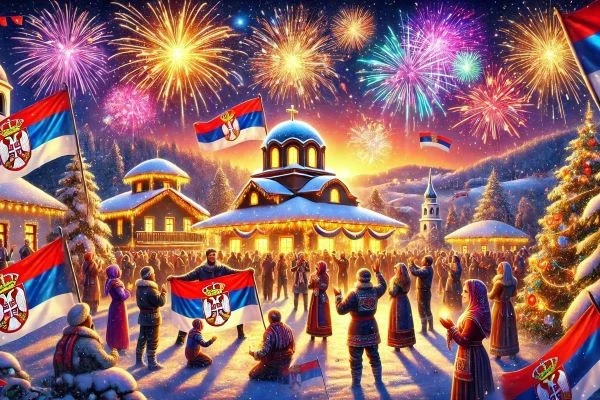What have Santa Claus and St. Nicholas in common?

One of the biggest Serbian holidays - Nikoljdan, a holiday celebrated by Serbs all over the world, is celebrated in honor of Saint Nicholas. This is also the time of New Year's holidays and the perfect opportunity to check what Saint Nicholas and Santa Claus have in common.
Serbian holidays are one of the most important Serbian features related to the history, tradition, spirit and customs of the Serbian people, and the holiday with the largest number of celebrants is Nicholas Day. December 19th is the day when half of Serbia celebrates, and the other half goes away. That is why, along with the New Year and Christmas, this day is considered a universal holiday in the Serbian people.
Who was Saint Nicholas?
Saint Nicholas is a historical figure from the 4th century AD. He was born in Patara (then Roman Empire) to father Theophanes and mother Nona, and later he was a bishop in the city of Myra. He was still a miracle worker during his lifetime, and in Christianity he is also known as Nicholas of Mirlikii or Nicholas the Wonderworker.
His image and work are respected in both Eastern and Western Christianity, and he is considered to be the protector of travelers, prisoners, the poor, but also of all other layers of society, especially children. He is one of the earliest saints who was celebrated throughout Europe. Holidays and Serbian celebrations dedicated to this saint are December 19, May 22 and every Thursday.
How did Saint Nicholas become Santa Claus?
Although many religious analysts do not agree with the idea that Saint Nicholas and Santa Claus have anything in common, a large number of people believe that Saint Nicholas served as an inspiration for the creation of the character of Santa Claus. It is interesting that in the gate of the church of St. Nicholas in the city of Mira, there is a statue of this saint in the form of Santa Claus, with the obligatory bag full of gifts for children.
Namely, from his life, which also tells about how Saint Nicholas gave gifts to three daughters of a poor man, the custom of giving gifts at Christmas arose. One of the important features of the Christmas holiday is precisely that Christmas charity - giving gifts to the poor. In our Serbian customs, this mostly "secret" giver of gifts was called Božić Bata, until the Second World War, and after that period he became better known as Santa Claus.
Another fact that is why it is believed that St. Nicholas "became" Santa Claus is that in Western cultures the name Santa Claus (Santa Claus) actually came about by shortening the name Santa Nikolaus (Saint Nicholas).
Whatever the truth, one thing is certain, Saint Nicholas arrives in many Serbian homes before Santa Claus. In our nation, he has always been celebrated as a household saint and protector, and his protective role is the greatest gift for the host. However, on this day, there are also other gifts to celebrate.
These are the best gifts from Serbia for the celebrants of this Serbian glory
The best gifts from Serbia are Serbian products that are part of Serbian tradition and folklore. These products carry and transmit to new generations the spirit of the Serbian people, an important combination of their history and personal and collective identity, and are therefore perfect as gifts for the celebration.
For St. Nicholas' Day, as for all other Serbian holidays, the most valuable gift is an icon. This especially applies to young celebrants who are just starting to celebrate. From the usual ones to the most luxurious ones, this time we suggest something in between: the icon of St. Nikole made in the art workshop "Serbian Tradition - Šeli" is an original handiwork. It is made using a combined technique modeled on medieval icons, and the filigree processed metal is gold-plated, silver-plated and decorated with zircons. Original gifts for the glory of St. Nicholas can also be traditional Serbian products related to Serbian customs during festivities, such as flasks, buklia or flasks with the image of the saint.
In our online store, you will find other original gifts for the celebration, everything from čokanjčić to rugs, everything that can be included in this category - the best gifts from Serbia.
Related products
Read also
Who was Saint Sava and what was his contribution?
"Saint Sava: A Beloved Serbian Saint with a Rich Legacy and Cultural Significance"
…Serbian New Year: Tradition, Customs and How to Celebrate it
The Serbian New Year, also known as the Orthodox New Year, is celebrated on…
Gifts Inspired by Serbian Culture: Authentic Ideas for the Holidays
The holidays are a time of giving, and finding the perfect gift is often a challenge.…
Traditional Serbian Christmas Customs: How to Cultivate Them in Modern Times?
Christmas is the most joyous holiday in Orthodox Christianity, a time when families…
How to Bring the Spirit of Orthodox Tradition into Your Home This Winter?
Winter is the perfect time to bring warmth, togetherness and the spirit of Orthodox…
Serbian Souvenirs: Perfect New Year's Gifts for All Tastes
New Year is the time of giving, and what is more beautiful than a gift that…
How to stay productive and not waste an entire day on Black Friday shopping
Black Friday is a day full of amazing discounts, but it can easily become exhausting…
Folk Beliefs and Customs for Saint Aranđel - Assembly of Holy Angels
Saint Michael the Archangel, who is celebrated…
Folk Beliefs and Customs for Đurđić - Glory of St. George
Đurđić, the feast of St. George, celebrated on November 16, is one of the most…
Smart shopper's guide: How to make the most of Black Friday
Black Friday is the most famous shopping event of the year that offers huge…
The history of Black Friday: How it all began and why it continues
Black Friday, known as the biggest discount day of the year, today attracts…
Gifts for Children in the Diaspora: How to Nurture the Connection with the Language, Culture and Tradition of Serbia
Children who grow up in the diaspora face specific challenges - they lose contact…

Apply for newsletter
Sign up for the Serbianshop newsletter and get a 10% discount.














